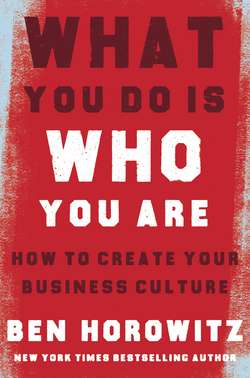Читать книгу What You Do Is Who You Are: How to Create Your Business Culture - Бен Хоровиц, Ben Horowitz - Страница 25
KEEP WHAT WORKS
ОглавлениеWhen Steve Jobs returned to run Apple in 1997, the company was in bad shape. Really bad shape. Its market share had fallen from 13 percent when Jobs was fired in 1985 to percent, and it was only a quarter’s worth of cash from insolvency. When rival computer maker Michael Dell was asked what should be done with Apple, he said, “I’d shut it down and give the money back to the shareholders.”
Even within Apple, almost everyone believed the conventional wisdom that the company’s death spiral resulted from what was known as personal computer economics. The theory of PC economics held that because the industry had commoditized PC hardware—there were IBM knockoffs everywhere—the way to make money was not to be a vertically integrated provider that gave the user the machine and its operating system, but to focus on the horizontal option: selling an operating system to run on someone else’s hardware.
Nearly every analyst was pushing Apple to make its Mac OS operating system the company’s product. In 1997, Wired proclaimed: “Admit it. You’re out of the hardware game.” Even Apple’s cofounder, Steve Wozniak, subscribed to this view: “We had the most beautiful operating system,” he said, “but to get it you had to buy our hardware at twice the price. That was a mistake.”
Steve Jobs disregarded that advice. In fact, one of his first acts as CEO was to stop licensing Mac OS to other hardware providers.
The industry’s other article of faith was that companies needed to maximize market share by having a presence in every link of the computer chain, from servers to printers to PCs to laptops. Likewise, they needed to make PCs in all shapes and sizes for every possible user. But Jobs immediately killed the majority of Apple’s products, including most of its PC models, as well as all of its servers and printers and its Newton handheld computer.
Why? Jobs saw the situation entirely differently. At an early all-hands meeting he asked, “Okay, tell me what’s wrong with this place?” He answered his own question: “It’s the products!” He went on to inquire, “So what’s wrong with the products?” and to answer himself again: “The products suck!”
For Jobs, the issue was not the economic structure of the PC industry. Apple just needed to build better products. He would need to transform its culture to make that happen, but it would only happen if he built upon Apple’s strengths, not Microsoft’s.
Integrating hardware and software had always been Apple’s core strength. At its peak, the company had focused not on industry benchmarks like processor speeds and storage capacity, but on building products such as the MacIntosh that encouraged people’s creativity. Apple did integration better than anyone else. Part of the magic was its ability to control the entire product, from the user interface to the precise color of the hardware. Jobs went out of his way to keep the employees who understood this, user-experience perfectionists like him. Jobs said about one such employee, the great designer Jony Ive, “He understands what we do at our core better than anyone.”
The company’s famous Think Different advertising campaign, which launched in 1997, featured creative geniuses such as Gandhi, John Lennon, and Albert Einstein. Jobs explained: “We at Apple had forgotten who we were. One way to remember who you are is to remember who your heroes are.” For Apple to become great again, it had to build on the aspect of its culture that had distinguished it in the past.
Jobs narrowed the product line to ensure that the company focused on delivering great experiences to individual humans rather than an impersonal set of specs, feeds, and speeds aimed at no one in particular. Over time, he would expand to include iPods, iPads, and iPhones, but he never went “horizontal”—he kept the software and hardware integrated. To further control the customer experience, Jobs even opened Apple Stores, which would become one of the best-performing retail businesses in the world.
When Steve Jobs came back to Apple, it was ninety days from broke. As of this writing, it is the most valuable company in the world.
When Apple was an industry joke, it must have been tempting to purge the old culture entirely. Jobs’s predecessor, Gil Amelio, tried to do just that. But like Louverture, the former slave who preserved the best parts of slave culture within his army, Jobs, the former founder, knew that Apple’s original strengths should be the foundation of its new mission.
